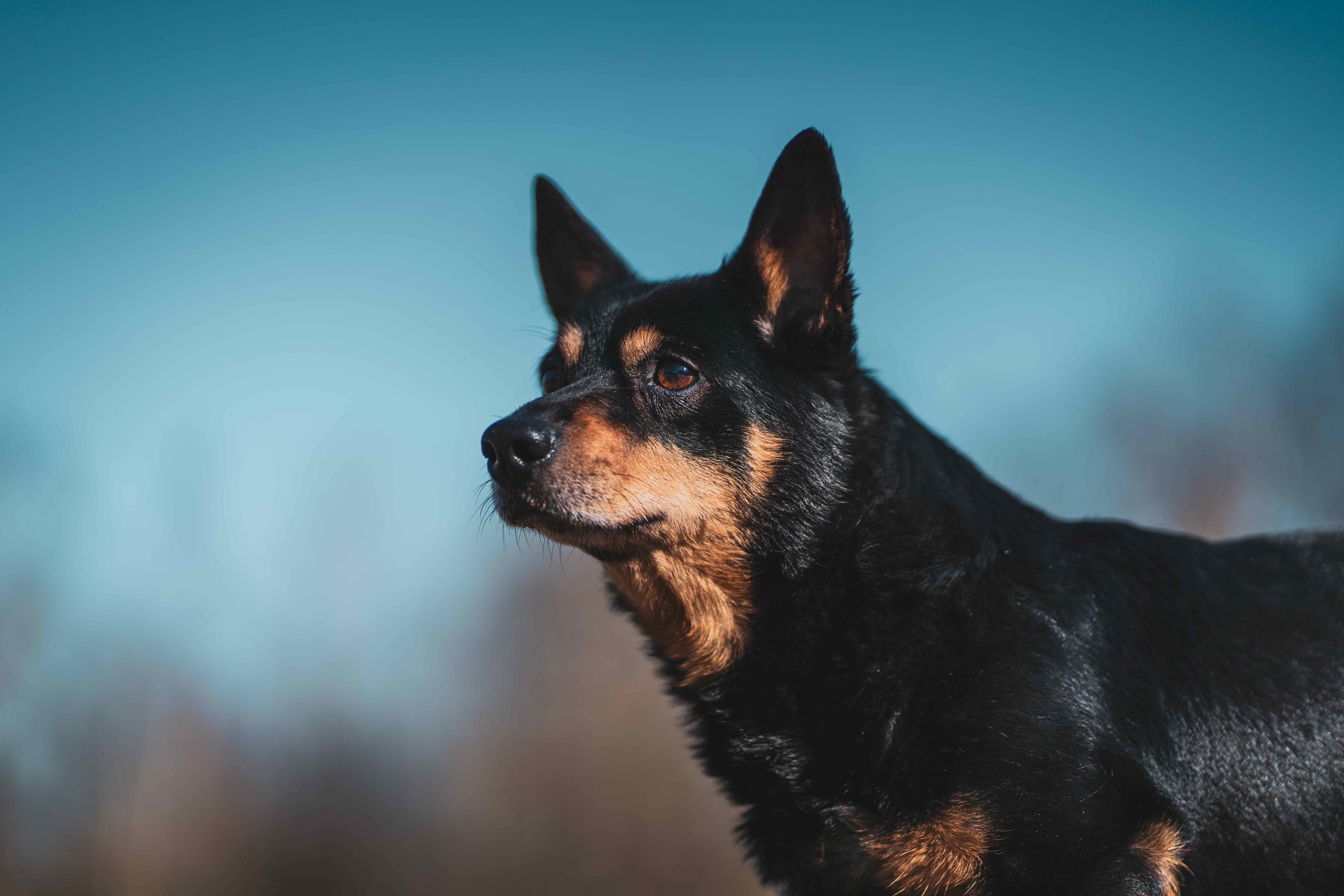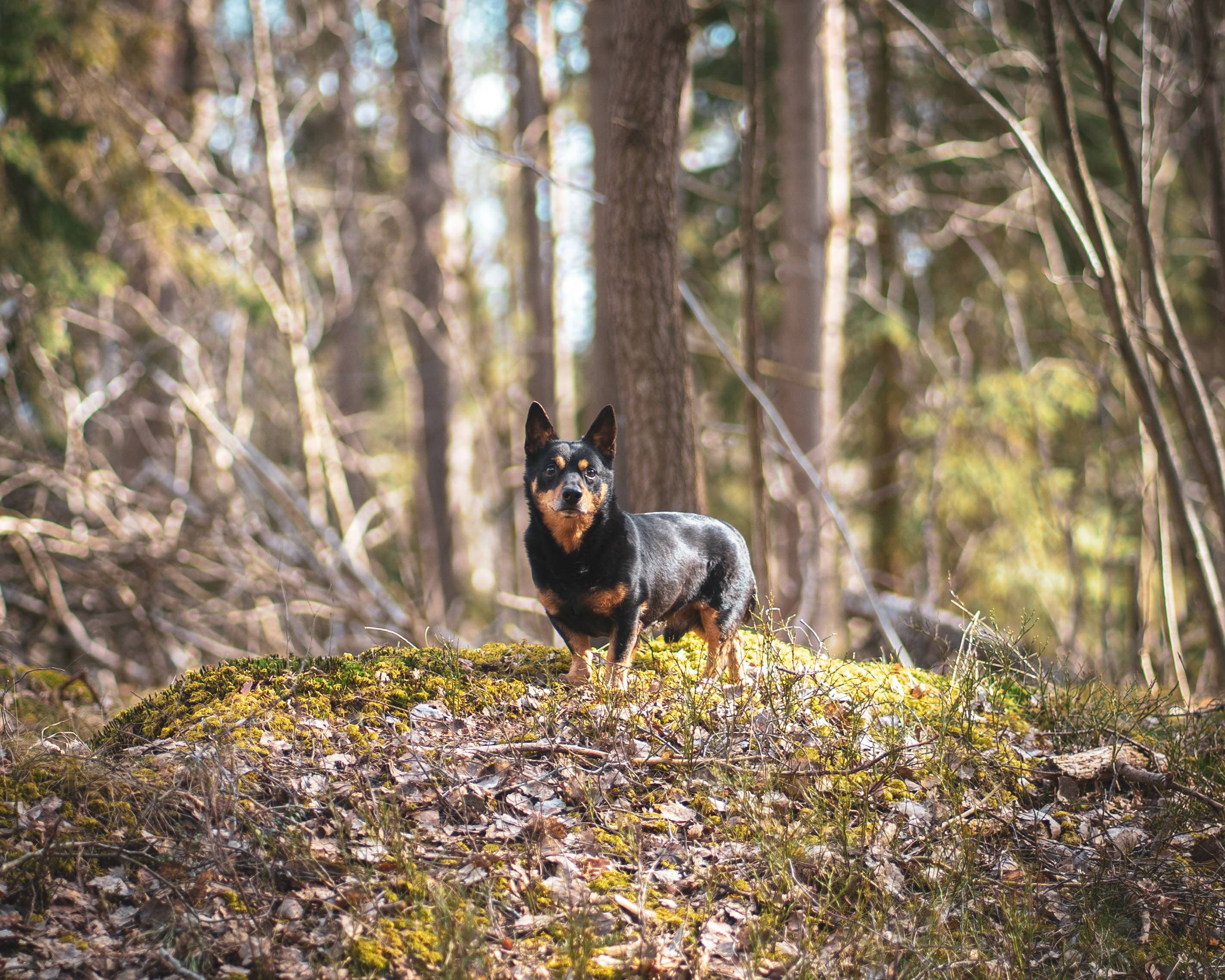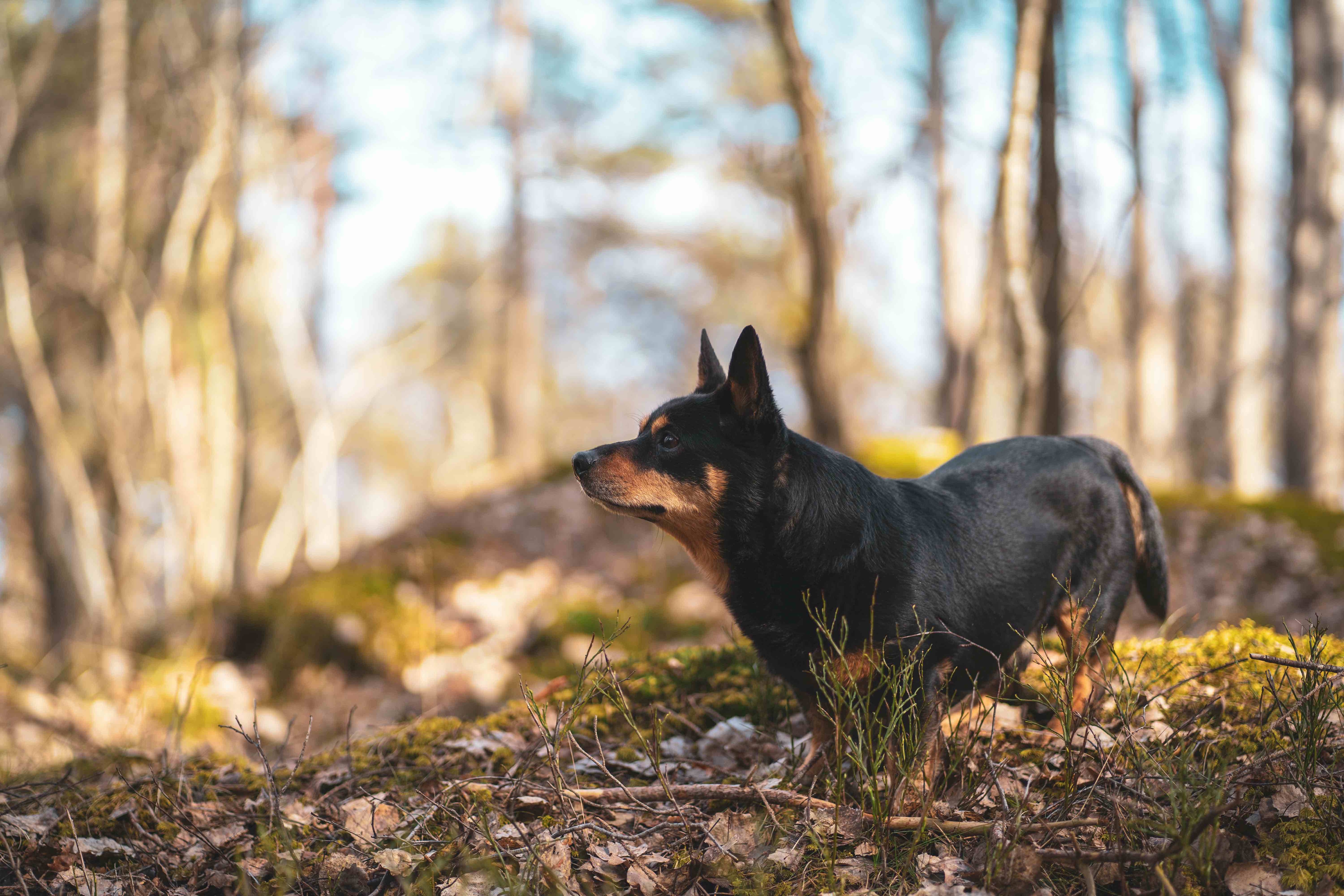Lancashire Heeler
Adobe Stock/Vera Reva
Lancashire Heelers hold several surprises within their tiny frames. For starters, while the breed only recently gained American Kennel Club (AKC) membership status, their origin story—though a bit hazy—likely dates to the 1600s.
The breed standard describes their ancestors as butchers’ dogs that would drive cattle to markets in West Lancashire, England. Commonly mistaken for a kind of Corgi or Manchester Terrier, the Lancashire Heeler is a possible descendant of these dogs but is a separate breed.
Though decidedly lap-size at 9–17 pounds, Lancashire Heelers aren’t lap pups. These herding dogs were bred to work cattle and historically helped with ratting duties. And while they can be excellent family companions (and even regularly curl up next to you), they need a job to be happy.
Caring for a Lancashire Heeler
Cute, friendly, and compact, it’s easy to understand why the Lancashire Heeler dog is commonly confused for a lap lounger. But these dogs won’t be content to laze the day away.
Bred to herd cattle and root out rats, Lancashire Heelers are intelligent, sturdy, and courageous dogs. Their brain and body must be put to use for them to thrive; daily walks, games, and canine sports can satisfy their exercise needs.
Regular exercise goes hand-in-hand with another need stemming from the Lancashire Heeler’s working background: companionship. They were bred to work alongside humans and haven’t lost their desire for togetherness. Heelers typically enjoy the company of people of all ages, as well as other animals. But given their small stature, it’s best to supervise their interactions with children and larger dogs.
And while you can expect to spend time training and socializing your Lancashire Heeler puppy, grooming will be a comparative breeze. Their short, dense, weather-resistant coat needs very little attention.
Lancashire Heeler Health Issues

The Lancashire Heeler is a generally healthy breed with a lifespan of 12–15 years. Still, like all breeds, they are prone to some health conditions. The United States Lancashire Heeler Club (USLHC) recommends testing for the following issues.
Primary Lens Luxation
Primary lens luxation (PLL) is a condition in which the lens of the eye moves out of its normal position. It can affect one or both eyes, and affected dogs may have eyes that are red, teary, cloudy, and painful.
PLL can also cause inflammation and glaucoma, and it can progress to blindness if left untreated. If caught early, surgically removing the lens can be helpful. Topical and oral medications can also help manage pain and discomfort.
Collie Eye Anomaly
Collie eye anomaly (CEA), also called choroidal hypoplasia, is a congenital condition in which the blood vessels of the choroid (the layer of tissue at the back of the eyeball) don’t develop properly and disrupt the flow of nutrients to the retina. This can lead to retinal issues like blind spots, retinal detachment, and blindness. CEA typically affects both eyes, but one eye may be worse than the other.
There isn’t a cure for CEA, and the disease isn’t reversible. However, medications can help manage symptoms in some cases. The good news is that the disease typically isn’t painful, and dogs with CEA can live long, happy lives with a little help from their pet parents.
Patellar Luxation
Patellar luxation describes when the patella (kneecap) moves outside of its normal groove within the femur. It’s one of the most common orthopedic conditions in small dog breeds.
The signs of patellar luxation vary according to the severity of the condition, but limping, bunny-hopping, and a popping or cracking knee joint are common. If the dislocation is severe enough, surgery may be recommended.
What To Feed a Lancashire Heeler

Every Lancashire Heeler is different, so it’s important to partner with your veterinarian to choose the best food for your dog. Your vet can help you identify a food that meets Association of American Feed Control Officials (AAFCO) standards and is nutritionally complete for your pet’s age, size, and health history.
How To Feed a Lancashire Heeler
Most adult dogs should eat two meals a day, once in the morning and again in the evening. But because Lancashire Heeler puppies are so small, they could be prone to low blood sugar (hypoglycemia). To help avoid this, it’s generally best to add a midday feeding for a total of three meals. Your vet can help you determine the best feeding schedule for your dog’s age.
How Much Should You Feed a Lancashire Heeler?
The nutrition label on your dog’s food bag includes a feeding guide that will give you a general idea of how much to feed your Lancashire Heeler based on their weight. But for a more precise answer, ask your veterinarian. They will tailor their recommendation to your dog’s age, weight, body condition score, lifestyle, and health needs.
Keep in mind that treats have calories, too, and they can add up fast during training sessions. Include treats in your daily calorie count for a more accurate view of what your pet is eating. Treats should never make up more than 10% of your dog's daily calorie requirements.
Nutritional Tips for Lancashire Heelers
If your Lancashire Heeler is eating a complete and balanced diet of dog food approved by the AAFCO, they shouldn’t need supplementation.
However, nutritional supplements and even prescription diets are sometimes used to treat or prevent certain health conditions. For example, your vet may recommend joint supplements if your Lancashire Heeler is diagnosed with patellar luxation.
Talk to your veterinary team before adding anything new to your dog’s diet.
Behavior and Training Tips for Lancashire Heelers
Lancashire Heeler Personality and Temperament
Lancashire Heelers are small in stature but high in energy, intelligence, and affection. These traits, coupled with their working dog instincts, mean they need a home where they are provided with daily exercise and close companionship.
While they were bred to herd cattle and hunt rats, your activities can be far less intense. Games of fetch and walks outside will appropriately stimulate their mind and work their body while giving them the attention they crave.
Lancashire Heeler Behavior
Lancashire Heelers will need constant guidance on how to limit some of their working dog instincts. When Heelers are bored and lonely with energy to burn, unwanted behaviors like barking and chewing tend to increase.
Heelers can be a bit reserved around strangers at first. But once they’re properly introduced, these pups can get along well with people of all ages and other pets. However, given their size, it’s important to closely supervise interactions between Heelers and children, or larger pets that may cause unintended harm.
Cute, friendly, and compact, it’s easy to understand why the Lancashire Heeler dog is commonly confused for a lap lounger. But these dogs won’t be content to laze the day away.
Lancashire Heeler Training
It’s important to safely expose your Lancashire Heeler puppy to various animals, people, environments, activities, and objects during their first 16 weeks of life. This is a crucial learning period, and socializing your pup can help them feel comfortable in a wide variety of settings. Talk to your Lancashire Heeler breeder about how they approach socialization, and ask your veterinarian what activities are appropriate based on your pet’s age.
Lancashire Heelers are loyal dogs that love their humans, but training a working dog to thrive in a home setting can take work. Consistent, positive training that uses rewards instead of punishment is the best approach. The training process is also a great way to provide Heelers with mental and physical exercise, and build the human-animal bond.
If you use treats as a reward during training, be sure to factor them into your dog’s daily calorie count. Play, toys, and other things your dog enjoys can also be used as rewards.
Fun Activities for Lancashire Heelers
Lancashire Heeler Grooming Guide

While Lancashire Heeler coats can be black and tan or liver (brown) and tan with short, dense, flat, weather-resistant fur. As you would expect for a working dog, these coats are low maintenance—though you can expect lots of shedding twice a year when they lose their undercoat.
Skin Care
Lancashire Heelers don’t require special skin care. Ask your veterinarian how often you should bathe your pet. Keep in mind that giving your Heeler too many baths can strip their skin of healthy oils.
Coat Care
Lancashire Heelers typically only need to be brushed around twice a week to keep their coat clean and healthy. During periods of heavy shedding (typically in the spring and fall), you may need to increase brushing to remove loose fur.
Eye Care
Lancashire Heelers are prone to eye issues. Watch for signs of disease, and call your vet if you notice anything out of the ordinary.
Ear Care
Talk to your veterinary team about how and how often you should clean your dog’s ears. Call your vet if you notice signs of an ear infection, such as redness, odor, pain, itchiness, and head shaking.
Considerations for Pet Parents
Before adding a Lancashire Heeler puppy to your family, ask yourself a few questions:
-
Do I have time to properly socialize a dog?
-
Do I have the skills, patience, and dedication to consistently train a dog using positive reinforcement?
-
Am I home enough to give a dog ample companionship?
-
Am I financially prepared to provide veterinary care to a dog?
-
Can I provide a dog with a loving home for their lifetime, which could be 15 years or more?
If you can answer these questions with an enthusiastic “Yes!” you may be ready to parent a Lancashire Heeler.
Lancashire Heeler FAQs
Are Lancashire Heelers good pets?
Lancashire Heelers are smart, affectionate dogs that can make good pets as long as their exercise and stimulation needs are met.
What group is a Lancashire Heeler in?
Lancashire Heelers are members of the herding group. They were originally bred to move cattle to market in Lancashire, England.
How much do Lancashire Heelers cost?
Cost varies by breeder, but you can generally expect to pay $1,000–$2,000 for a Lancashire Heeler puppy. Reach out to the United States Lancashire Heeler Club for more information on finding a reputable breeder.
Are Lancashire Heelers rare?
Yes, Lancashire Heelers are a rare dog. The AKC estimates that there are only around 5,000 Lancashire Heelers in existence.
